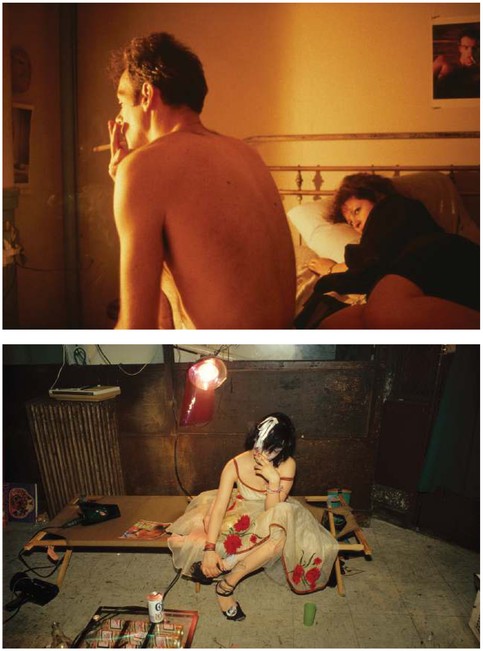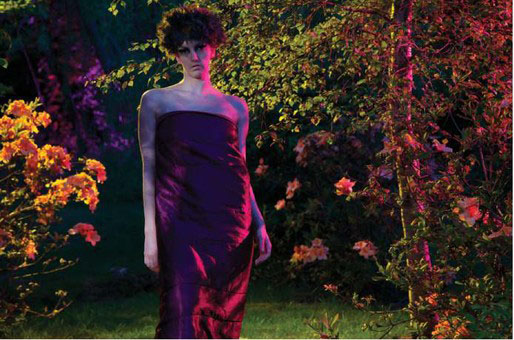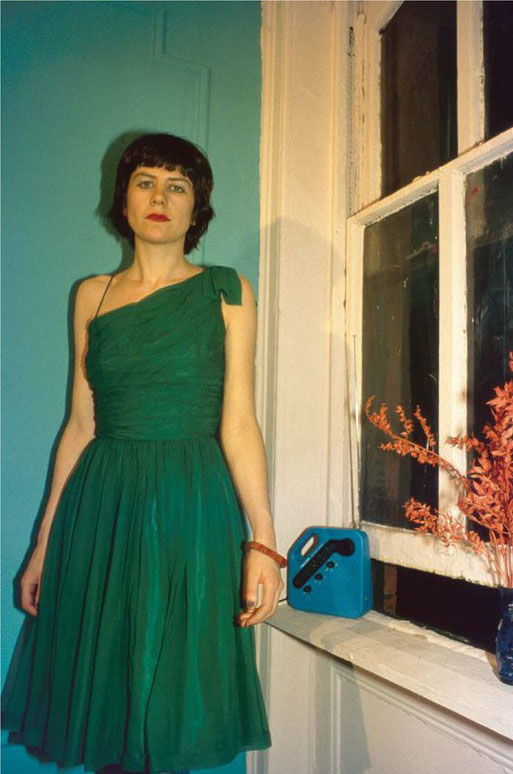In Conversation: Nan Goldin & Vivienne Dick
Legendary queer photographer Nan Goldin agreed to do just two interviews when visiting Dublin for the opening of her exhibition with Irish feminist lmmaker, Vivienne Dick at the Irish Museum of Modern Art. One of them was with GCN, and we decided it would be good to get the two women together for a conversation. Mary Nally took just about a minute to agree to put it on the record.
When I was asked to meet Vivienne Dick and Nan Goldin for GCN, it took a minute to agree. They’re like these legendary rockstars who’ve been part of a time in New York that I’ve obsessed over since my first visit there. The art, the fashion, the music, the city, the blackout, the freedom, the parties… Would you be able, like? No. But I said I’d try.
I first met Vivienne a few years ago. Up until then I’d only known her at a distance from the Irish art scene, that she was this underground hero; an avant-garde film making genius. Born in Killybegs, Donegal she felt there was nothing for her in Ireland and moved to New York in the ’70s. She began making Super 8 films during this time, and became a key figure in the ‘No Wave’ scene. It is here that she also met the legendary photographer Nan Goldin. The artists often feature in each other’s work. ‘Vivienne in the green dress, NYC’ is an iconic photo from Goldin’s most well-known work The Ballad of Sexual Dependency, a slide show of over 700 images set to a soundtrack which documents the artist’s intimate personal life.
For our interview, we meet in a Dublin hotel lobby, Vivienne introduces me to Nan, who says, “Is it okay if we go outside for a cigarette?”
Standing outside having a fag, the two launch straight into the chats about life. Over the next hour and a bit we cover and touch on all sorts of subjects – how they met, social media, acronyms, falling in love, learning to drive, friendship, queerness, branding, addiction, landscape, spirituality, meditation, stalking, mythomaniacs, dressing up in Killybegs, the Burren, the light in the west of Ireland, the Del-Byzanteens, sky-watching, music, identity, art, hash from the Khyber Pass, rainbows in the grass, a town called Steidlville, Repeal the 8th, coming out, getting up, death and ‘why is the gay flag hung the wrong way around in this town?’.
There’s confusion over who the link is, regarding when the two first met.

Nan after being battered, New York City, 1984 – Nan Goldin Nan and Brian in bed, Bowery, 1983 – Nan Goldin Trixie On The Cot – Nan Goldin
We can’t accept that our power is being taken over by an elite and that it’s normal for people not to have a home or housing.
Nan: We met in ’78. She [Vivienne] came over; I’d moved to New York like a week before and I was living with other mutual friends, and she came over to pick us up for a Thanksgiving dinner for ex-patriots and people who didn’t have family…
Vivienne: Can I just ask a question here, because I’m trying to remember, how did I get your address? Was it from Claire?
Nan: From Anthony. He asked you to pick us up; I don’t know how he got it.
Vivienne: I’ve no idea, so that’s a mystery.
Nan: It was like a blind date, but we don’t know who set it up.
Vivienne: I knocked at their door, to pick them up, to go to this Thanksgiving dinner.
Nan: She was wearing a green and orange mini dress, and I thought this is one of the most beautiful people I’d ever seen. It was like friendship at first sight. Then she started hanging out with us.
It’s a gorgeous and fascinating thing to be in the company of two friends who’ve been friends longer than you’ve been alive. A lot of the time, I just sit and listen to Nan and Vivienne reminisce about other friends and situations from their past and present. There’s lots of laughing and a few gems I’m sworn to secrecy on. Both friendship and the work they do are incredibly important to their lives. Their lifestyle was never a statement. They made work for themselves and their friends with no agenda, no brand building, raw and true. And their influence is everywhere, no doubt unbeknownst to the influencees currently being branded as influencers from curating an Instagram existence. It’s a strange world we live in. I’m glad of the grounding that an hour in the company of their realness gives.
I want to know about that period in New York, and that scene that they rolled in. Did they know they were living what could be seen as a queer lifestyle, or was it even thought about?
Nan: We didn’t see ourselves as LGBT, but some were gay and some weren’t. It was united by music, by a desire to… a community that was based on, you know, art. But more like just independence; like freakiness, I guess you could say, in a good way. Like just people who didn’t want to be part of the social norm. To me that was always normal, but I guess it was still outside, or some form of rebellion. Do you think so?
Vivienne: I do think so. I was really interested in women who were part of the new music scene and who were…
Nan: Music was a big part of it.
Vivienne: …who were playing instruments, who had their own bands and who were doing all this wild music, and quite a few of them, not all, would have been gay, but you didn’t think of them as gay, that was the thing.
Nan: You didn’t identify each other as gay.
Vivienne: It didn’t matter one way or the other.
Nan: Vivienne was a huge influence on me. Not in her choices of music, as much as the study of music, like looking deeply into music. I’d grown up with a gay man and he listened to a lot of Joni Mitchell, and you know the girls, Barbra – that kind of stuff. But around Vivienne I started looking into more eclectic music, more unknown music. I still do. And also the way she used music in her films was a huge inspiration on The Ballad and the way I use music.
Vivienne: Yeah, the music, it’s there in The Ballad. It’s almost as if the music is saying something, it’s part of the story of the film, the words of the songs.
The music very much assists the narrative in both artists’ work, and they themselves feature regularly in each other’s. From parties in New York City to the landscapes of the West of Ireland, the work has also been inspired by both.

Still from Red Moon Rising, 2015 Vivienne Dick
Nan: That picture I took, that I call ‘God’s Fingers’ – the mountains with the little streams, that’s in Galway. That’s the most incredible light I’ve ever seen, or ever photographed. And Vivienne’s films are a lot about landscape.
Vivienne: The last one is about the smallness of our place in the universe.
I’ve tried to bring a lot of people out in my life, as gay, but also from just as whatever their form of repression is, I guess.
To me, what I see as being important to these two artists is breaking down barriers – for themselves, for women, for queers. Creating without compromise.
Nan: I think Vivienne and I share and intense curiosity about people. Vivienne’s interest in women and women’s power, I really love that. I’ve tried to bring out a lot of people in my life, as gay, but also from just as whatever their form of repression is, I guess.
It can happen through photography, it can help them like themselves more. I think every time I’ve taught, at least one person comes out in my class. It’s this desire to help people liberate themselves in some way. But it’s not as focused on women as I think Vivienne’s work is. Women’s strength, women’s force seems to be so important to her.
Vivienne: When I was growing up at school, it was all women. It was a women’s world. I was at boarding school, so when I left it was a shock to the system. I just felt there was nothing here [in Ireland] for me and that it was a man’s world, and it really was.
The only work open for me was teaching, and it was very defined. You know, you did the H-Dip, became a teacher and your Dad would be pleased. You’d be in a pensionable job and he’d want you to buy a car and settle into a whole lifestyle, and I just thought there had to be something better in the world than this, you know? So I took the first opportunity to leave.
And aren’t we all the better for it. There has been much magic created from the moment these two artists met. They are pioneers who have shaped photography and film and they continue to influence and inspire. Much has changed since the early years of their friendship, some for the better and some for the worse. Before our time together ends, I ask what both women think is important in today’s world?

Vivienne in the Green Dress, NYC, 1980 – Nan Goldin
Nan: I think to be politically diligent.
Vivienne: I think kindness is important, and I agree with Nan about the diligence. We can’t accept that our power is being taken over by an elite and that it’s normal for people not to have a home or housing. We have to really start questioning all those things. It is going to take us working together to do something about it.
Nan: Absolutely.
‘93% Stardust’ by Vivienne Dick and ‘Weekend Plans’ by Nan Goldin are currently on show at the Irish Museum of Modern Art,
www.imma.ie